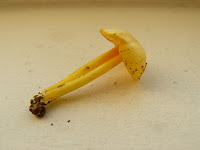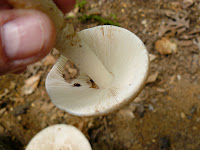 It is not everyday that one encounters bright colored mushrooms. Indeed, most mushrooms I find are wheat-colored, gray, brown, white or other dull color. Therefore, a bright yellow, blue, purple or red thing in the forest is always a cool find and it always makes me think of the utility of color for fungi. From what I understand, a common explanation is that bright colors are used as a warning for predators (although this mushroom is not poisonous). I am not sure this explanation is applicable to macrofungi but I would love to know ;-). Whatever is the cause, this bright lemony-yellow solitary mushroom was popping out of the dry leaves about a month ago and, although I planned to write about it, for a long time I couldn't find a good time to do it.
It is not everyday that one encounters bright colored mushrooms. Indeed, most mushrooms I find are wheat-colored, gray, brown, white or other dull color. Therefore, a bright yellow, blue, purple or red thing in the forest is always a cool find and it always makes me think of the utility of color for fungi. From what I understand, a common explanation is that bright colors are used as a warning for predators (although this mushroom is not poisonous). I am not sure this explanation is applicable to macrofungi but I would love to know ;-). Whatever is the cause, this bright lemony-yellow solitary mushroom was popping out of the dry leaves about a month ago and, although I planned to write about it, for a long time I couldn't find a good time to do it.So here it goes.
Date: 11/13/2010
Location: Scott's Run Nature Preserve, VA
 Habitat: Solitary, growing on the ground, over dead leaves
Habitat: Solitary, growing on the ground, over dead leavesMeasurements
Pileus diameter - 24 mm
Pileus height - 7-8 mm
Stipe length - 42.5 mm
Stipe diameter at apex - 7.5 x 3.0 mm
Stipe diameter at middle - 7.0 x 3.0 mm
Stipe diameter at base - 5.7 x 3.0 mm
Description
Pileus - Convex, smooth, yellow-orange, shiny when fresh and dull after 1 hour, flesh is thin, yellow, cuticle is glabrous, odor is mild and non-distinctive, taste is mild and non-distinctive
Hymenium - Gilled, gills are adnexed, well spaced, pale yellow, undulated
Stipe - Central, equal, hollow, compressed, splitting, yellow-orange, surface is smooth, glabrous
Spore print - not obtained
Impressions
This is a specimen of Hygrocybe flavescens. The lemon-yellow color and compressed, splitting stipe are quite characteristic, making the identification very easy.
Reference
Roody, W.C. Mushrooms of West Virginia and the Central Appalachians




















































